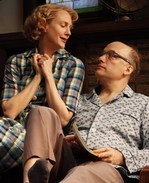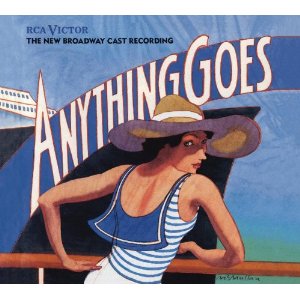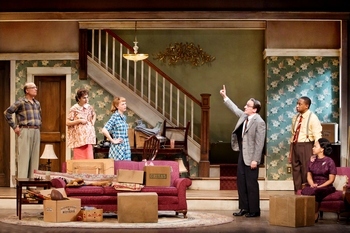SITE GUIDE
SEARCH
REVIEWS
REVIEW ARCHIVES
ADVERTISING AT CURTAINUP
FEATURES
NEWS
Etcetera and
Short Term Listings
LISTINGS
Broadway
Off-Broadway
NYC Restaurants
BOOKS and CDs
OTHER PLACES
Berkshires
London
California
New Jersey
DC
Connecticut
Philadelphia
Elsewhere
QUOTES
TKTS
PLAYWRIGHTS' ALBUMS
LETTERS TO EDITOR
FILM
LINKS
MISCELLANEOUS
Free Updates
Masthead
A CurtainUp Review
Clybourne Park
By Elyse Sommer
Bruce Norris's Clybourne Park on Broadway —Finally By Elyse Sommer
If you didn't see Clybourne Park during its Playwrights Horizon run in 2010, don't miss the chance to see it now that it's finally made it to Broadway, albeit for a limited 16-week run. If you saw it before, see it again. Second-time-arounders won't have that rare sense of encountering a terrific new work and find themselves muttering, as I did, that "this ought to get the Pulitzer for best drama" before it actually did. But they WILL be pleasantly surprised to be even more taken with Norris's ability to simultaneously provoke and entertain. Clybourne Park's numerous out of town productions between it's long delayed move from an Off to On Broadway theater have proved that the play is strong enough for other capable directors and actors to make it a welcome addition to any neighborhood (see our reviews of productions in London and DC). However, it's great to have the original director, crafts team and ensemble aboard at the Walter Kerr. The members of the acting septet. once again demonstrates their versatility. If anything, they've deepened their performances and the subtly planted ties between the first act set in 1959, and the second one fifty years later. With our country still bleeding money and lives in an ever more hopeless far away war, the ultimately tragic connections between 408 Clybourne Street then and now, is more moving than ever. Watching the actors again move seamlessly from one persona to another, I was more taken than ever by Frank Wood's incredibly masterful way with letting tension simmer beneath a laid back exterior and seeing Christina Kirk and Annie Parisse totally transform their looks as well as their characters' personalities. The actors are all too good to single out a favorite. However, I was newly smitten with Crystal A. Dickinson's way of showing her frustration, both as the maid in act one and the long-standing home owne uneasy about the neighborhood's gentrification. David Gumpton's white folks pleasing husband, displaying a razor-sharp irony as her more independent minded mate in act two is also more impressive than ever. Jeremy Shamos is beyond excellent as the unctuous Karl Lindner, the one character most closely linked to Lorraine Hansberry's A Raisin in the Sun which served as a departure point for Clybourne Park. Lindner's appearance at the house he tried to dissuade Hansberry's Younger family from buying and Norris's Russ and Bev from selling to an unnamed black family is the connecting thread between both plays. Besides being a unique use of one play to jump start another completely original one, the Clybourne Park setting makes one wish that Hansberry could leave her too early tenure in the great beyond long enough to see this play and take heart that its winning the Pulitzer is a way of having Raisin belatedly share that honor. If there's anything I'd like to see differently done in this production, it would be to see the curtain left up during the intermission, so that one could see the wizardry with which scenic designer Daniel Ostling and his elves subtly change the condition of that Clybourne Park house. Otherwise, my comments about the 2010 premiere apply to the current, highly recommended Broadway production. And so, please read on, by scrolling past the production notes or clicking here. Broadway Production Notes Cast (same as at Playwrights Horizon in 2010):Frank Wood (Russ/Dan), Annie Parisse (Betty/Lindsey), Christina Kirk (Bev, Kathy) ,Jeremy Shamos (Karl/Steve), Crystal A. Dickinson (Francine/Lena), Brendan Griffin (Jim/ Tim & Kenneth), Damon Gupton (Albet/ Kevin) Scenic design: Daniel Ostling Costume design: Ilona Somogyi Lighting design: by Allen Lee Hughes Sound design: John Gromada Hair and Wig Design: Charles LaPonte Stage Manager: C. A. Clark Running Time: 2 hours with one intermission Walter Kerr Theatre 219 West 48th Street From 3/26/12; opening 4/19/12; closing 8/12/12 Reviewed by Elyse Sommer at April 18th press matinee Original Review REVIEW FEEDBACK Highlight one of the responses below and click "copy" or"CTRL+C"
Paste the highlighted text into the subject line (CTRL+ V): Feel free to add detailed comments in the body of the email . . . also the names and emails of any friends to whom you'd like us to forward a copy of this review. |
|
Bev, I'm not here to solve society's problems. I'm simply telling you what will happen, and it will happen as follows: First one family will leave, the another, and another, and each time they do, the value of these properties will decline, and once that process begins, once you break that egg, all the kings horses, etcetera. . .— Karl the self-righteous Rotarian in Act 1. The history of America is the history of private property. . .This is why we have wars. One group, one tribe, tries to usurp some territory-- and now you guys have this territory, right? And you don't like having it stolen away from you. . . — Steve in Act 2, at a meeting about keeping the house he and his wife are renovating from encroaching on the neighborhood's architectural integrity turns into a racial confrontation. |

Christina Kirk and Frank Wood
|
In terms of construct, Clybourne Park is more like the recently reviewd British import, The Pride, (Richard Greenberg's Three Days of Rain also comes to mind). Like The Pride this is not a new story but rather another instance of the cliche about the more things change, the more they remain the same. However, Mr. Norris has applied the full force of his provocateur's wit and his gift for sparkling, often overlapping, dialogue to the device of having the situation play out in two different eras. Consequently, there's nothing trite or overly familiar here.
Unlike David Mamet's less than galvanizing Race, Clybourne Park confronts the race issue with much more flair. The turnabout viewpoint could easily be a gimmicky piggybacking on Hansberry's landmark drama. However, Norris moves beyond the structural novelty and A Raisin In the Sun tie-in, so that what starts like a sort of mid-American drawing room comedy builds into a social drama that's as disturbing as it is funny. The script cleverly connects the two eras with parallel dialogue and interaction. The playwright also manages to let the family tragedy that prompts the first act's family to sell their home make a meaningful and poetic contribution to the unsettling second act denouement.
The setting is the same both for Clybourne Park's 1959 and 2009 sequences. While the locale never changes, the condition of the house. Daniel Ostling scenery is a telling commentary on all the changes the neighborhood has undergone. The characters in each act have different names and personas but the actors are the same, which adds another fun to watch element, especially given the top drawer performances.
If there are any standouts in this cast honors probably should go to the first three actors we meet: Frank Wood and Christina Kirk who get the plot started as Russ and Bev and Crystal A. Dickinson as Francine their live-out maid. The living room of Russ and Bev's house is still fully furnished, but there are packing boxes all around to indicate that Russ won't be sitting in the armchair reading the National Geographic and absent-mindedly snacking from a carton of ice cream. Bev is clearly not as relaxed as Russ and as they banter about the meaning and origin of Neopolitan (the flavor of the ice cream Russ is eating), there's an aura of tension, even a touch of menace, permeating the seemingly casual back and forth. There's also something less than easy and relaxed in Bev and Francine's relationship, with Francine probably refusing the chafing dish Bev wants to give her, because, well-meaning as the offer is, it comes off as patronizing.
The uneasiness overhanging the house, the despair showing through Russ's calm exterior (Wood is a master of understated tension) comes a bit more to light with the arrival of Jim (Brendan Griffin), the family minister. The racially charged situation surrounding the house sale explodes shortly after the arrival of family friend and Rotarian Karl (Jeremy Shamos) and his deaf and very pregnant wife Betsy (Annie Parisse). Anyone familiar with Shamos and Parisse is likely to do a double take as both are almost unrecognizable. They inhabit these roles with comic excess but then Norris is not averse to giving some broad strokes to his humor and Betsy's deafness is actually an apt metaphor for the all-around deafness that keeps racial and marital issues boiling from generation to generation.
Without going too deeply into plot details. Russ and Bev do not intentionally sell their house to a black family but their carte blanche to the real estate agent nevertheless makes them the ones to breach the Clybourne Park color bar. All of Karl's efforts — at first friendly and reasoning, eventually angry enough to open the pandora's box of Russ and Bev's tragedy — come to naught. And so, fast forward to 2009 and the metamorphosis of Karl and Betsy into Steve and Lindsey, an upscale professional couple. The short and convenient commute that made the suburbs appealing to Russ, has grown longer so that the proximity to the inner city has prompted Steve and Lindsey to abandon their suburban life style for gentrification-ripe Clybourne Park.
Naturally, since Clybourne Park has, true to Karl's predictions, gone through some bad times, the house we saw in act one is hardly in move-in condition. Consequently, Lindsey and Steve have hired an architect who seems bent on turning it into one of those McMansions that have become a luxury blight in so many communities. The present day sequence revolves around Lindsey and Steve's meeting in the empty house with their realtor (Brendan Griffin, without his minister's collar), their lawyer (Christina Kirk now a cool career woman who's shed her blonde curls and stay-at-home wife image). Also present are Lena and Kevin (Crystal A. Dickinson and Damon Gupton, last seen as the maid and her white folks pleasing husband Albert), two black home owners who, having hung in rather than head to the suburbs during the neighborhood's downturn, and now want to insure that newcomers respect the area's architectural and historic integrity.
This more sophisticated group of people again start off amicably enough, their banter about names of places now linked to their vacation trips rather than an ice cream brand. But concerns about the height of the renovation inevitably turn toxic with racism coming to the forefront.
Director Pam MacKinnon sees to it that the ensuing all-around bad behavior is actually more fun to watch this time around. The actors excel in underscoring the differences and connections between their 1959 and 2009 roles.
Frank Wood, while not an active participant in the discussion about the renovation, is again outstanding in a peripheral but significant role that leads to the laughter to stop and the two acts to be tied together with a strong tug at the heart strings.
The New York premiere production ran at Playwright Horizon's main stage with same cast, director and design team from 1/29/10; to3/21/10.

Slings & Arrows- view 1st episode free
 Anything Goes Cast Recording
Anything Goes Cast RecordingOur review of the show
 Book of Mormon -CD
Book of Mormon -CDOur review of the show


